congratulations!!!
Take Home Preparations!
thank you for choosing A huckleberry hills doodles & poodles puppy!
THEY ARE YOUR HUCKLEBERRY!
Here are some basic take home preparations for you to get started on before your new puppy comes home.
Ideal new puppy setup
This is our ideal new puppy setup!
- Puppy playpen
- Waterproof puppy pad lining floor to avoid any damage to flooring and to create a barrier for keeping puppies warm
- Litter box placed inside the playpen
- Kennel with open door
This will help to create a wonderful, cozy and private space for new puppies going home!
convenient links to items we recommend:
PuppyGoHere Dog Litter Pan Litter Box Training.
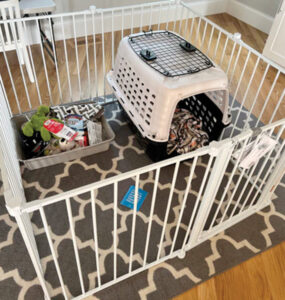
DIET
An important item in our take home preparations is your puppy’s diet. Your puppy has started his/her life being fed premium grade puppy kibble called Life’s Abundance All Stages. Depending on the size of your puppy, your puppy has been fed three to four times a day. This should be maintained during the biggest growth spurts of your pups life. Because they are growing they will need all the nutrition they can get.
You are not contractually obligated to maintain the Life’s Abundant All Stages food. Please be thorough with your research if you decide to continue this once your pup comes home and do what is most comfortable for you! Following these take home preparations for your new puppy will help the adjust more smoothly.
When switching to a different kibble I recommend a high calorie quality diet. They are given Bene-Bac probiotic, a probiotic paste to help aid in their digestion and health. Please continue the probiotics especially during any transition of food, this is great to continue for consistent stool and overall digestion help, as puppies are notorious for having sensitive stomachs especially their first year of life. Best transition is to add water/broth to their kibble (1 TBS canned pumpkin puree with each meal) and time… they will eat when they are settled and hungry.
We also recommend giving your new puppy a multivitamin daily! We like to use Tomlyn Nutri-Cal high calorie dietary supplement. It provides puppy appetite stimulation and is any excellent source of vitamins & minerals.
There may be soft stool until they have been on a kibble for a short while, Bene Bac aids in this transition well. When switching from Kibble to Kibble it is a gradual transition, because their stomach digests each differently trying to do both may confuse their gut more than help it. If you decide to switch foods, switch slowly: 3 days – mix 1/4 new food with 3/4 food Life’s Abundant All Stages; next 3 days – 1/2 new food with 1/2 Life’s Abundant All Stages; next 3 days 3/4 new food with 1/4 Life’s Abundant All Stages; then after, 100% new food.
convenient links to items we recommend:
PetAg Bene-Bac Plus FOS & Probiotics Gel Supplement

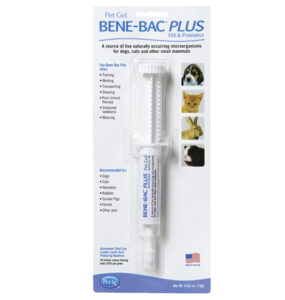

TRAINING
Something you can begin working on from our take home preparations is discovering various ways to potty train. Read up online or watch YouTube videos to discover a myriad of ways to help you potty train. Your pup has been in training to use the bathroom in a litter box! While I understand you may not have a doggie door, or be home enough to continue the training, please try to encourage your new pup and be persistent. This teaches them that the bathroom is for outside only and they have been using it exclusively! Of course, weather conditions and the new environment may hinder/confuse their continued progress for a short time, but with persistence and giving them a word command (Go Potty) with a specific spot to go they will catch on very quickly at your home with the base they already have from here.
We suggest crate training them for the evenings and keeping it next to your bed so you can wake if they whine and need to go out, but do not let them play. Night time is to go to the bathroom. We encourage you not to even talk to them, just take them to do their business, then back in the crate. They are like babies, and may cry at you until they are used to this schedule, so please be consistent with it. A schedule and knowing they can count on you as their Owner/Boss/Alpha is extremely important, especially the first part of their life in knowing their place and part in the family.
All new homes are set up differently, remember these are suggestions in our take home preparations that we have found helpful. Try different systems and find what works best for you and your pup and family (dog door, bell on door, smaller confined spaces until they “earn”’ more space with no accidents and going back if they have a mistake). These are all ways we teach our pups here in our home and everything with persistence works!
Be mindful of slick stairs, jumping off of beds, walks or runs that are too long, etc., during the bigger and earlier growth spurts as their joints are more susceptible to injury.

Simplistic way to potty train:
- After they wake up
- After they eat
- After they play
- Every hour take them potty
- Always say “Go Potty” to mark what they are to do
Establishing a scheduled routine helps tremendously. Something like this:
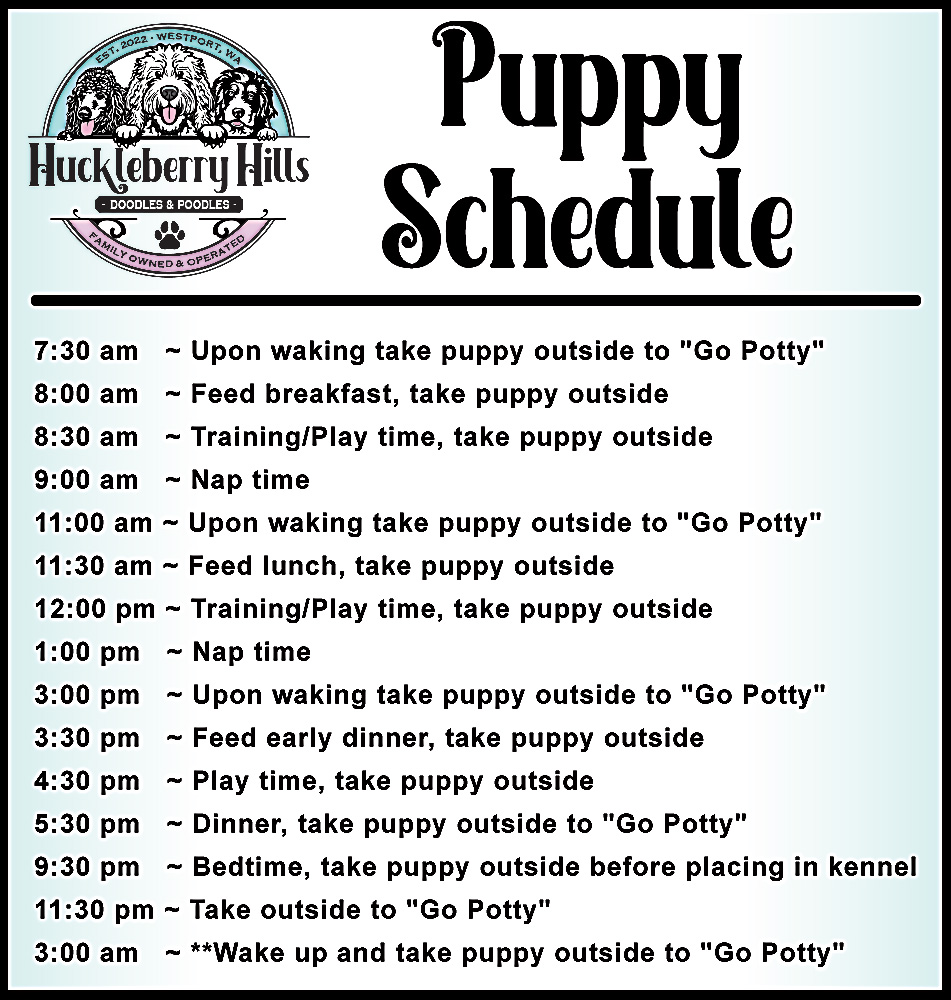
VACCINATIONS
5-in-1 First Puppy Vaccination consists of: Parvovirus, Canine distemper, Adenovirus 2, Parainfluenza. Your puppy’s vaccination record will come home with her/him. Our puppies health is important to us. The puppies receive their first round of shots between 7.5-8 weeks. Our take home preparations section shows the first shot your new puppy has received and displays the pattern of vaccinations that most vets follow at 3-4 week intervals.
Continued puppy socialization is important while still young and just being separated from their littermates. If there are other dogs or puppies that you know they are up to date and current on their own vaccinations and healthy it is ideal to set up such “play dates”. Avoid taking your puppy on walks, dog parks, pet stores, or as a rule of thumb anywhere other dogs may have walked that you don’t know, until all of their puppy vaccinations are complete, usually around 4 months. We refer to this as “Four Off The Floor.” This time with you at home is ideal as they are learning your cues and rules, you can practice walking on leash around the house so they are already comfortable with you and visa versa for when you head outdoors.
Continue getting required puppy vaccinations (3 or 4 sets depending on vet) 3 weeks apart with rabies at the conclusion. Deworming, Heart worm medicine, Flea and Tick meds need to be administered based on the needs of your location. By examining all of this info in our take home preparations, you can prepare your questions to ask your vet at your appointment.
VACCINATION SCHEDULE
Puppy’s Age Recommended Vaccinations Optional Vaccinations
- 8 weeks: DHPP #1 MLV (distemper, adenovirus [hepatitus], parvovirus, parainfluenza)
- 12 weeks: DHPP #2 MLV (distemper, adenovirus [hepatitus], parvovirus, parainfluenza)
- 16 weeks: DHPP #3 MLV (distemper, hepatitus, parvovirus, parainfluenza, parainfluenza)
- 20 – 24 weeks: Rabies (“killed” vaccine)
- 12 months: DHPP MLV Booster
- 13 -16 months: Rabies Booster (3 year “killed” vaccine, 3-4 weeks after DHPP booster)
- Every year DHPP Booster: NONE NEEDED. Duration of immunity 7.5 / 15 years by studies for distemper and 7 years for parvo, lifetime.
- Every 3 years Rabies (“killed”) Booster: 3 yr. vaccine given as required by law in California (follow your state/provincial requirements)
*OPTIONAL: Coronavirus (only affects < 6 weeks old), bordetella, parainfluenza (for social dogs: dog parks, day camps, boarding, etc)
*OPTIONAL: Leptospirosis, lyme disease (if travel where endemic)
Read the vaccine protocol below to learn more about the optional vaccines:
Vaccine Protocol by Dr. Jean Dodds DVM
PARASITE MANAGEMENT
Talk with your veterinarian about parasite management and develop a proactive parasite management plan that addresses both internal and external parasites. Parasites are extremely common in puppies and adult dogs can have them too! Talk with your vet about the types of activities your puppy will be engaged in (e.g., hiking, shared puppy play spaces, puppy day care) and invest in preventative care. Also talk to your veterinarian about parasite management across the lifespan and formulate a deworming, flea and tick, and lice treatment schedule with guidance from your vet. Proactive and preventative care are your best defenses against parasites. We also recommend blocking your pups access to feces. Try your best to prevent your puppy from playing with, eating, or sniffing feces of any kind. In the event your puppy does come into contact with feces you will want to wash him/her immediately. Make sure you are sanitizing your pups food and water bowls daily because they can harbor parasites. All these are important items to remember from our take home preparations for your new puppy. See links to example dewormers, flea, tick, and chewing lice medications below as well as informational articles on parasite management. By researching the various items below, you can
convenient links to items we recommend:
Frontline Plus Flea and Tick Treatment
https://www.akc.org/expert-advice/health/parasites/
Managing Parasites in Dogs and Cats
TRAVEL
One of the most important items in the take home preparations is deciding how will you get your puppy home to you. There are a few options to get your baby home to you…
OPTION 1:
You can fly to pick up pup making a trip out of it and fly back with pup in cabin or do an in-out flight same day and bring your pup in cabin back home on your return flight. There is a fee for in cabin pets to ride with you and that depends on the airline (typically $75-$125 in addition to your flight costs). We usually meet you at the airport at the departure area so there is an easy check in for you, or you can pick up at our home if you have a rental car.
OPTION 2:
If you are close enough and want to drive to pick up your pup, you are welcome to.
OPTION 3:
We have used flight nannies, too. Pups on the Fly is a company we have used. If you visit their website, you can understand their process and request a quote. We encourage you to look into having them schedule an actual flight (cost increases) because they usually fly standby and delays in delivery have occurred and then costs for hotels stays are additional.
OPTION 4:
We also have used ground shipping through Four Legged Kids Bus Pet Transportation: (909) 568-5696 ask for Janet she is the Travel Coordinator. They are located in Chino Hills, California 91709.
All four ways of travel are safe for your baby. We would never endanger one of our pups as they are making their way home and any form of travel usually puts them right to sleep, the hum of the car & plane and the baby over stimulation of it all. When you have chosen your puppy, then we will discuss what form of travel you would prefer and the next steps.
CRATES, COLLAR/HARNESS & BRUSHES
This is another area in the take home preparations that can be purchased before new puppy arrives. Remember, the size of the crate you purchase will depend on a couple things: are you planning on using it only for potty & puppy training while young? If so, you can get away with a smaller one and replace it with a dog bed in the later months after they have earned their trust around the house or you have an alternative room they have access to while you are away. Do you want to have a consistent crate they can go to and call their own for their life? Then I would suggest getting a large or XL (depending on estimated adult weight), wire kennel that you can set up in a specific spot that has an additional crate sizer so you can only allow enough room for them to stand, turn and lay back down as they grow and are training and can be opened up when they are older and trained to go to when they need to be out of your hair or when you are away from home. This will be based on your training methods and structure you implement for your dog.
We also suggest, while potty training to line the crate with a towel or small blanket that you can pull out, wash and replace as necessary. A big fluffy bed will only make it harder to clean and give them the opportunity to show you just how sharp those puppy teeth are and possibly ingest some cotton/stuffing.
We always use a harness for young puppies, this way while you can’t take them out on walks around the neighborhood until vaccinations are done, it will give you the opportunity to practice walking around your home without tugging on their neck. After the points of largest growth, invest in a more permanent, larger collar. Martingale collars are wonderful because as your dog’s hair grows it won’t get tighter and cause matting. There is an adjustable section that loosens during rest sitting comfortably on their necks, not getting tangled. But the collar tightens during engagement like when going on walks and keeping them near you. Others have enjoyed the rolled leather, as it does not cause matts with the longer “doodle” haired dogs. Find what works best with the hair length you like to keep on your dog. The fluff of their hair can be deceiving so make sure there is still room between collar and neck (general rule is two fingers under collar). But make sure that the collar cannot be tugged up over their head if they pull back.
We included these two brushes in our take home preparations because we use them to brush our dogs’ hair when it gets longer are:
- Long metal comb ~ gets down to the skin for deep matts (behind ears, collar area, hind quarters)
- Flat bristle / Slicker brush ~ brushes out the top layer helping ease into the deeper comb brushing
*Your groomer may suggest other brushing or grooming aids for the length of hair and amount of wave on your pup.
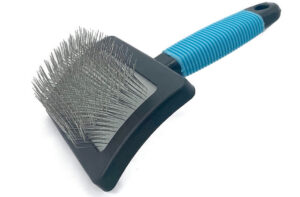
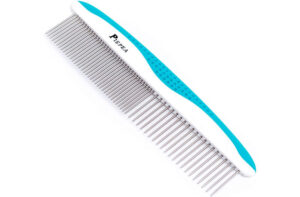
MICROCHIP
According to AKC Reunite, “Pets with microchips are up to 20 times more likely to be reunited with their owners.” The thought of losing a puppy forever is too much to bear. Therefore we have taken the opportunity to microchip all our puppies for their future homes. The Puppy Go Home Bag will have instructions on how to transfer your name onto your puppy’s microchip.
PET INSURANCE
We believe that your pets health and happiness is worth it! You want to protect your pet and your finances. The concept of medical insurance for pets is fairly straightforward—pay a monthly premium to be covered for unexpected, costly veterinary expenses. Our puppies come with a free month of coverage from Trupanion and our Puppy Go Home Bag contains information detailing how to continue coverage.
Many of the items mentioned in our take home preparations
can be purchased ahead of time.
We hope this will help you plan, purchase and
schedule for all the important items needed for your new puppy!
We look forward to all the pictures,
updates, and stories of your puppy in their new FOREVER home!
Thank you for sharing your excitement with US!
